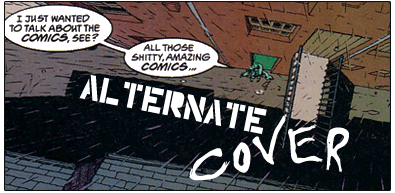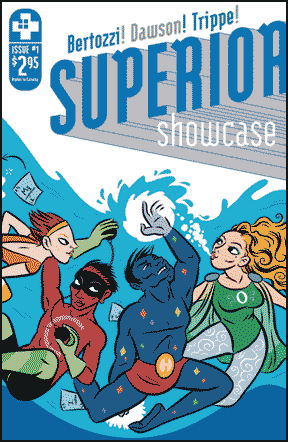Alternate Cover Special - Superior Showcase #1

Once in a while comes a week of comics so uninspiring that there's just no way I'll be able to bring myself to take the time to review them all properly. This week's big release was "Moon Knight #1" for christ's sake, and I can't even pretend to be interested (doubly so now that I've read it). Instead, I'm going to spend my time on the only comic I was interested in this week for an extra-long review-turned-article, partially based around Adhouse Books' Superior Showcase about what happens when the worlds of Superhero and Independant comics collide.
Superior Showcase #1 continues Adhouse's marriage of indie creators and mainstream concepts as originally conceived for their 288-page anthology, Project: Superior. Both this and the original collection take a sly, self-aware look at the genre while applying the sensibilities you can only find in the small press - but why is it such an odd pairing? What, if anything, makes it so special, and how come it doesn't it happen more?
While superheroes dominate the direct market for US comics, they're all full of incredibly familiar themes and plots and sometimes you can't help wonder if you've read it somewhere before. That's not necessarily a bad thing, of course - like any other media, the most popular comics tend to be familiar and inoffensive, and, for want of a better word, a little safe. Well-crafted, yes, and engaging, yes, but they're not going to be experimental and they're not going to be personal. And they're not going to be about anything besides superheroes, because that's what sells.
Make no mistake, I'm not some superhero apologist - I read these comics and I'm fine with that. You don't go into a Schwarzenegger film or switch on an episode of Eastenders expecting to have your world-view altered, and I don't pick up an issue of X-Men with any more expectation than to read a bit of escapist fiction - it's the oft-ignored elephant in the room of superhero comics that while great things can be done with them, the truth is far closer to the public perception - that superheroes are a bit kiddy. It's the flip-side of the argument that paints superheroes as modern counterparts to the gods, myths and legends of old - which works worly in iconic tems, though the main difference is that no-one was asked to write a new story about Zeus or Theseus or King Arthur once a month for 60 years.
So let's face it, mainstream comics might look pretty and offer a good read but they aren't always art. In fact sometimes, it's barely even more than advertising. If someone on the outside sees a superhero comic, they're seeing action figures and cartoons and adolescent power fantasies. They're seeing comics readers as people who haven't properly grown up. They're not seeing a serious medium.
Tthe indie scene exists almost as a reaction to that. Even now the range of genres covered by the big three publishers (Marvel, DC and Image) is low, limited to action-based work that'll appeal to the broadest range of buyers. The indie scene is for people who might want to read a comic that doesn't have an editorially-mandated fight scene once an issue. In fact, indie fans can get downright snobbish about people who might read superhero comics, considering their pet books far more intellectual and advanced.
It was surprising, then, that when Adhouse invited creators to get involved with Project: Superior it the final print ended up at more than twice the length of the previous year's Robot/Sci-Fi anthology Project: Telstar.
There's an obvious reason for that. Behind almost every independent, self-publishing, comics artiste there's more than likely an adolescent kid who grew up reading Spider-Man and secretly wants to have a stab at it themself. Things like Project: Superior give them an irony-laced way to do that without facing the disdain of their fans and peers. Like it or hate it, there's no escaping the simple truth that the medium is dominated by capes and anyone working in it is bound to have something to say on the subject, and in the case of indie creators, they're often the people with the least chance to say it, unless an alternative publicher will give them a mouthpiece.
Which brings us to the comic itself - Superior Showcase #1 contains 3 stories from 4 creators not usually associated with superheroes, doing superhero stories.
 |
Superior Showcase #1
Publisher Adhouse Books • Creators Nick Bertozzi, Mike Dawson, Dean Trippe & John Campbell
So the question is, what's the point? Why bring these guys to superheroes? Why force a square peg into a round hole? The answers are between the covers. What we've got here is an exploration of human issues through superhuman eyes, though that's maybe a little charitable at times (Bertozzi, I'm looking at you) because by its nature, an anthology book is highly prone to wildly variable quality.
Bertozzi takes the opening shots with his 8-page "Super*Mart." It's a short look at a convenience store staffed and frequented entirely by superheroes and villains. But that's about it. The story relies entirely on the art to prop up the central hooks of the story: a pun on the word "supermarket" and the juxtaposition of characters with ludicrous names and costumes working in a convenience store. It's all a little pedestrian, if you took away the costumes and names, this wouldn't be a very engaging story - this is the direct opposite of what I found with Project: Superior where the addition of those genre conventions worked to enhance the story. Without those prois, there doesn't seem to be a story here. Bertozzi's art is probably an acquired taste - I'm a big fan of cartoonists as much as comic artistry so I enjoy it, it's the strongest part of his offering, that's for sure, but it may not be for everyone.
Mike Dawson takes up the next 14 pages with his thankfully far stronger story about Ace Face, the Mod with the Metal Arms. This is actually a follow up to some shorts contained within Project: Superior, where we learnt the origin of Ace Face and witnessed his continuing adventures throughout his life over several short stories, so it's only fitting that Dawson rounds of the career by showing his fall from grace during his twilight years. Having given up the super hero game, Ace Face has become a teacher, giant metal arms still attached. However, it eventually falls to him to deal with something that threatens his students - but this can he still handle it? It's a story made funny by the writing and art, but one that also has an emotional core. We're rooting for Ace Face, and when we see his downfall it's genuinely shocking and disturbing, since we know he was only trying to do what's right. This is exactly what I was looking for - an indie creator using superhero genre conventions to enhance his story about a man trying to do what's right and being failed at every turn, both inside and outside the system, and eventually paying the price for it. Worth the cover price alone (though I'd highly recommend reading the other Ace Face stories first!)
The final 10 pages are a story about Trippe's teen sidekick character, Butterfly (an obvious analogue of Robin) by Trippe and Campbell. It, too, is wonderful stuff. Like Ace Face it uses the fantastic setting to tell a normal story. Butterfly is reaching the age where he's getting a bit angsty, and his mentor, Knight-Bat, has seen it all before. It takes a Hallowe'en adventure with his own young sidekick for Butterfly to drag him back from the brink of assuming a new darker indentity like the previous Butterfly, now named Nightbird. If anything, it's funnier than Ace Face, with the villains of the piece being Hipster Ghosts that look and act the part - "They come out when they sense something sincere might happen... on Hallowe'en" - though my favourite scene in the entire book comes later when Butterfly's new sidekick defeats the ghosts by shouting "Smile when you're happy! Make your parents proud!" at them. I hate to resort to quoting it just to show how great it is, but it's some wonderful writing.
So that's what you get. A few stories which use superheroes in unconventional ways to tell conventional non-superhero stories. So, since I did myself the displeasure of asking myself the question earlier - what is the point? Primarily, I suspect the exercise is to make superhero readers pay some attention to non-superhero comics and creators through this kind of "gateway" indie comic - a similar experiment, Jim Mahfood's Generation X Underground Special, got me into the indie scene. Otherwise, it may just be a good excuse for those creators to play with some new toys for a bit.
I've seen some articles suggest that there's an element of industry self-loathing involved in asking these creators to "lower" themselves to this sort of work, but it's clear from the reading of the stories that no-one actually thinks of it like that. There's nothing so barbed in here as Jhonen Vasquez's hilarious take on the big guns, big tits 90s superheroes as found in the Squee collection, for instance - these people do genuinely seem to love superheroes, which is why there's an innocence and warmth in the stories. You'd be doing yourself a favour to buy Superior Showcase - it's never too late to find out about what alternatives exist in comics, especially when the work gets this good. A-.
About this entry
- By James Hunt
- Posted on Tuesday, April 11 2006 @ 11:05 pm
- Categorised in Comics
- 0 comments
